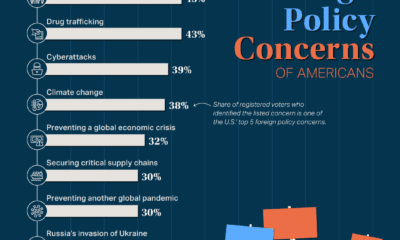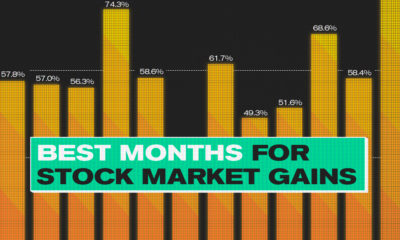Investors were already tiptoeing on broken glass, knowing that the longest U.S. stock market bull run in history was getting long in the tooth. Then, when the market foresaw the potential damage that could be caused by the COVID-19 pandemic, it quickly created a vortex that would suck almost everything into it.
Bizarro Market
In the last week, markets flipped into an alternate universe. Every major stock got crushed, while suddenly those holding onto stockpiles of toilet paper and soup reigned supreme. In such unique circumstances, we wondered which companies were weathering the storm of volatility. To do this, we used Finviz to pull up a visualization of S&P 500 performance, then investigating the segments of the market that were doing well in spite of the recent plunge. A few companies not only avoided the chaos — they actually thrived over the last week. Let’s look at why!
Not Getting Bugged Down
With global travel, events, and social gatherings screeching to a halt, it’s obvious that this is not a winning situation for any typical economy. However, it’s hard for everyone to simultaneously be a loser, and it’s always inevitable that some stocks will benefit from any crisis — or at least not get hit as hard as their peers.
Zoom Video Communications (ZM) There’s no doubt a pandemic is tough on brick-and-mortar companies, but for most white collar workers the show must go on. As a pure play stock in the video conferencing category, Zoom is uniquely positioned as companies shift to more remote work. Domino’s Pizza (DPZ) With people wanting to avoid crowds because of COVID-19, it’s natural to want to order in. Domino’s, as well as other companies that focus on food delivery, stand to benefit in the short term from the virus. Campbell Soup Company (CPB) Campbell is the quintessential counter-cyclical stock, and even more so in a prepping environment. When the global outlook is gloomy, people want to stockpile — and soup is a major pantry staple. Teladoc Health, Inc. (TDOC) If sitting in a doctor’s office with dozens of other sick people can be avoided, it seems it would be regarded as a prudent decision. For this reason, remote health services are an obvious focus for investors during the pandemic. The Clorox Company (CLX) Wash your hands. Wash your hands. Have you heard that you should wash your hands to avoid the spread of the coronavirus? Clorox benefits from this sudden interest in sanitation and cleanliness. Everbridge, Inc. (EVBG) When times are uncertain, global decision-makers want to get as much quality information as possible. Everbridge offers a risk intelligence platform that provides this service. Virtu Financial, Inc. (VIRT) Whether markets are going up or down, large amounts of volume and volatility are a good thing for financial services companies that make money from high frequency trading.
Not all of these companies are in the green — some have simply traded sideways — but on average, they’ve seen a 12.7% bump in price over the last week. Whether that will last in a fast-changing news environment is another story. on Today’s chart measures the extent to which 41 major economies are reopening, by plotting two metrics for each country: the mobility rate and the COVID-19 recovery rate: Data for the first measure comes from Google’s COVID-19 Community Mobility Reports, which relies on aggregated, anonymous location history data from individuals. Note that China does not show up in the graphic as the government bans Google services. COVID-19 recovery rates rely on values from CoronaTracker, using aggregated information from multiple global and governmental databases such as WHO and CDC.
Reopening Economies, One Step at a Time
In general, the higher the mobility rate, the more economic activity this signifies. In most cases, mobility rate also correlates with a higher rate of recovered people in the population. Here’s how these countries fare based on the above metrics. Mobility data as of May 21, 2020 (Latest available). COVID-19 case data as of May 29, 2020. In the main scatterplot visualization, we’ve taken things a step further, assigning these countries into four distinct quadrants:
1. High Mobility, High Recovery
High recovery rates are resulting in lifted restrictions for countries in this quadrant, and people are steadily returning to work. New Zealand has earned praise for its early and effective pandemic response, allowing it to curtail the total number of cases. This has resulted in a 98% recovery rate, the highest of all countries. After almost 50 days of lockdown, the government is recommending a flexible four-day work week to boost the economy back up.
2. High Mobility, Low Recovery
Despite low COVID-19 related recoveries, mobility rates of countries in this quadrant remain higher than average. Some countries have loosened lockdown measures, while others did not have strict measures in place to begin with. Brazil is an interesting case study to consider here. After deferring lockdown decisions to state and local levels, the country is now averaging the highest number of daily cases out of any country. On May 28th, for example, the country had 24,151 new cases and 1,067 new deaths.
3. Low Mobility, High Recovery
Countries in this quadrant are playing it safe, and holding off on reopening their economies until the population has fully recovered. Italy, the once-epicenter for the crisis in Europe is understandably wary of cases rising back up to critical levels. As a result, it has opted to keep its activity to a minimum to try and boost the 65% recovery rate, even as it slowly emerges from over 10 weeks of lockdown.
4. Low Mobility, Low Recovery
Last but not least, people in these countries are cautiously remaining indoors as their governments continue to work on crisis response. With a low 0.05% recovery rate, the United Kingdom has no immediate plans to reopen. A two-week lag time in reporting discharged patients from NHS services may also be contributing to this low number. Although new cases are leveling off, the country has the highest coronavirus-caused death toll across Europe. The U.S. also sits in this quadrant with over 1.7 million cases and counting. Recently, some states have opted to ease restrictions on social and business activity, which could potentially result in case numbers climbing back up. Over in Sweden, a controversial herd immunity strategy meant that the country continued business as usual amid the rest of Europe’s heightened regulations. Sweden’s COVID-19 recovery rate sits at only 13.9%, and the country’s -93% mobility rate implies that people have been taking their own precautions.
COVID-19’s Impact on the Future
It’s important to note that a “second wave” of new cases could upend plans to reopen economies. As countries reckon with these competing risks of health and economic activity, there is no clear answer around the right path to take. COVID-19 is a catalyst for an entirely different future, but interestingly, it’s one that has been in the works for a while. —Carmen Reinhart, incoming Chief Economist for the World Bank Will there be any chance of returning to “normal” as we know it?












